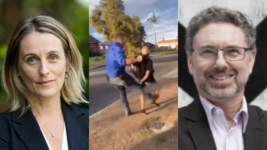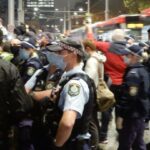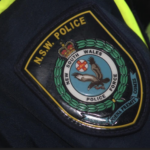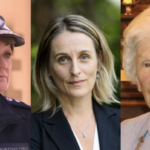Leg Sweep, Anyone? NSW Police Continues Reign of Excessive Force, Despite Rising Calls for Reform

A NSW police officer arrested an 18-year-old First Nations man with a disability on suspicion of two attempted break and enters last week. And as the officer walked his captor away, the teen dropped to the ground having a violent seizure, yet the thug in blue simply pulls him up and drags him along.
Further footage of the Taree incident shows the pair walking together post-seizure, when the officer, seemingly out of nowhere, performs a leg sweep, kicking out the teenager’s feet and dumping the boy down onto the base of his spine. The boy reported not being able to move in his cell that night.
NSW police has stated that an internal investigation will inquire into the officer’s behaviour. But so what? Officers use the leg sweep on a daily basis. Admittedly, they don’t usually save it until a suspect is obviously in custody. And most of the time, the manoeuvre results in a face first drop.
That’s what occurred in May 2020, when a constable applied a leg sweep on a 16-year-old Aboriginal boy, who’d sworn at him, and the teen’s face hit a brick path. Similarly, officers slammed Sydney personality Danny Lim face first into a tiled floor last year, after one performed the sweep.
Last week’s incident is the fourth time since May that police have been called out for use of excessive force, which under the law is considered the crime of assault. And while the young First Nations man told his aunt that he thought he might die, the other vulnerable people subjected to police excessive force all did die as a result of officers’ “policing”.
Lethal manoeuvres
“There is absolutely a need for a review into the use of the leg sweep by NSW police,” National Justice Project director George Newhouse told Sydney Criminal Lawyers, in response to a question about what must be done regarding rising police brutality.
“We back calls by Sue Higginson MLC for a parliamentary inquiry into NSW police,” the lawyer continued, “because the public deserves to know exactly how and when police will use the leg sweep and other dangerous techniques.”
Two officers approached 78-year-old Lim in Sydney’s QVB mall last November. He was wearing his trademark boards displaying political messaging, when officers grabbed an arm each, pulled him forward and up, then one applied the leg sweep, and they slammed him face first into the ground.
Carried out with balletlike precision, the footage of the manoeuvre suggests that the leg sweep is a move officers are well trained in. And it’s an action that also results in the suspect lying face down in the prone position, which permits officers to apply the full force of their bodies upon their captive.
The prone position is known to have led to multiple Aboriginal deaths in custody.
The 2020 incident involving a 16-year-old Aboriginal teen in a Surry Hills park saw a constable, who couldn’t handle an insult, waltz over to the boy, spin him around, pins his elbows behind him and kick his legs out. After the teen hit the ground, several officers applied their weight upon his back.
“The work of the National Justice Project has already seen changes to the way police use the prone position in WA,” added Newhouse.
“The coronial inquests into the deaths of Ms Wynne and Roderick Narrier have resulted in a restriction in the use of this dangerous hold – but this must go further, and other states should follow suit.”
Killing those in need
“I am calling for a select committee inquiry into NSW police responses to vulnerable people as I see this as the best mechanism available in NSW parliament to examine the issue, to shed real light on what’s going wrong with policing and police responses,” said NSW Greens MLC Sue Higginson.
“In just the last few months, we have seen multiple critical incidents that have resulted in police killing someone,” she stressed, “including a person experiencing mental health distress when they were called out to do a welfare check.”
On arrival at a nursing home on 17 May to deal with a 95-year-old woman, who suffered dementia and was holding a steak knife, Senior Constable Kristian White didn’t apply the leg sweep as the great-grandmother was approaching him using the aid of a walking frame.
So, instead the officer determined to taser the elderly woman, causing her to fall and leading to her death in hospital a week later.
On the day following Clare’s death, NSW police officers were called out to deal with a man having a mental health episode in a North Willoughby street, and as he approached them carrying two chief knives, officers neglected to reach for their tasers this time, and rather shot the man four times.
And the last police killing occurred in mid-July, when officers were called to out to perform a welfare check on a man in Glebe, and when he appeared out the front of his residence holding a knife, one officer tasered him and then their partner shot him dead, just for good measure.
“An inquiry can shine a light in all places and hear from witnesses who have direct experience of policing,” Higginson advised. However, she’s found that senior police officers and the minister are rather suggesting these are “isolated incidents of poor policing” despite “what the evidence shows”.
Sticking their heads in the sand
“Police are one of the few institutions in the country who are permitted by law to use force against people,” Newhouse made clear. “That power needs to be exercised cautiously.”
“Over the years, governments have increased power to use force without accountability. It is absolutely vital that we rein in such violent police actions.”
As the solicitor’s comments suggest, what NSW police and the Police Association of NSW want, they tend to get, regardless of which major party is in power. And this has led to one of the largest police forces globally, wielding truckloads of enforcement powers, with next to no accountability.
“Instead of acknowledging that this is an issue with the system of policing and supporting my call for a select committee inquiry, the police minister has been deflective and avoidant, and the matters have been dealt with internally,” remarked Higginson.
The NSW Greens justice spokesperson added that police investigating police is ineffective. And another clear issue leading to the use of excessive force as usual, is that NSW police simply pays out millions in compensation annually to sweep its casualties out of the public mind.
“If we are able to appropriately inquire into the issue, we may be able to uncover where we’re going wrong and how we can begin the work to repair things and develop a better, more accountable and transparent system of policing for the long-term,” Higginson concluded.







